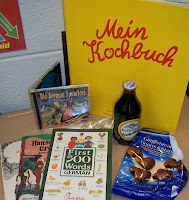The Discovery Center came about during my first year of teaching after a student asked me a question about something, and I didn't know the answer. I told the class we would look it up and do a little research project on it together. I ended up typing up a three-page report, putting it up on the bulletin board, and making a few questions for them to answer for extra credit.
Afterward, I was going to take it down, and the kids wanted me to do another one. This turned into a weekly project of mine. I loved putting it all together, and the kids loved doing it. I eventually, over the course of two years, made enough topics to change them out every single week. It took some time, but it was worth it.
 |
| Sample Quiz |
What Is It?
It's a bulletin board that is changed weekly (or almost weekly), which has topics not covered in class. They are often
topics closely related to the curriculum or holiday, but not covered by state performance indicators. The boards usually have 3 or 4 pages of laminated information on a topic that has been written and tailored for the specific grade level, in my case, third grade. There is a quiz for each child, which has 5-6 questions. They have to read the information in order to answer the questions. This is also good for
test-taking skills.
 |
| Rewards Poster |
Who Can Do It and How Are the Questions Assessed?
Any student who has finished their work is allowed to do the Discovery Center, one student at a time. It is optional, but the students become a bit competitive over the reward system, so most kids end up doing it. This is an
enrichment tool that can be offered to every child,
no matter their ability level.
I have a poster chart with the student's names on it. For every question a student gets correct, that's how many stickers they get on the chart. For each 10 stickers, they receive a reward. The rewards get bigger and better the more that the students participate and gain stickers.
 |
| Discovery Center Book Box |
Supplements
I made a box called "Want To Know More?" in which I place many different levels of books related to the topic for that week on the Discovery Center board. Any child is free to read the books from the Discovery Center box, no matter if they have taken the quiz or not. The way I see it is that perhaps if they are drawn into a book, they are not only reading, but they may be interested in the quizzes, as well.
Topic Suggestions
I came up with some topics on my own, based on the related curriculum, but I also have asked my students over the years in what kinds of topics they would be interested. I have listed a few of the topics below.
-Carnivorous Plants -Vikings -Snakes -Spiders
-Explorers -Sharks -Bats -New York City
-Egypt -Ice Cream -St. Patrick's Day -St. Valentine's Day
-George Washington -Chocolate -Bunnies -Landmarks of the World
-Volcanoes -Human Body -Butterflies -Martin Luther King, Jr.
-Bees -Conservation -The Moon -Dinosaurs and Fossils
-Penguins -US Symbols -Me -States of Matter



































